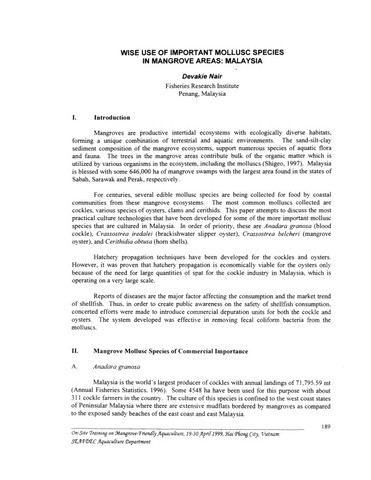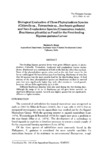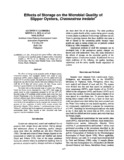Bacterial depuration of grossly-contaminated oysters, Crassostrea iredalei.
Share
Abstract
Oysters (Crassostrea iredalei ) from a commercial growing area in Capiz, Iloilo, Philippines, were purchased from the Iloilo City Central Market and used in a depuration trial within 24 hours of collection. Total coliform (TC) and fecal coliform (FC) levels were determined using the five-tube, most probable number (MPN) technique. Samplings were carried out in three areas in the tank: (a) near the water trickle are, (b) at the middle and (c) near the water outflow area. FC proved to be a better and more consistent indicator of depuration efficiency than TC which gave erratic levels in the first 24 hours. The oysters with initial FC MPN of 2.2 x 10 super(5)/100 g meat depurated to acceptable levels (< 230 MPN/100 g meat) after 48 hours except those in the middle of the tank (490 MPN/100 g). This suggests the presence of an "indifferent" or "dead" spot. Nevertheless, the same oysters depurated successfully within 72 hours. Ranges of chemical and physical parameters in the depuration water were: temperature, 27.0-29.5 degree C; salinity, 30.5-32.0 ppt; and dissolved oxygen, 4.0-6.2 mg/l.
Subject
Taxonomic term
Collections
Related items
Showing items related by title, author, creator and subject.
-
Wise use of important mollusc species in mangrove areas: Malaysia
Nair, Devakie (Aquaculture Department, Southeast Asian Fisheries Development Center, 2000)For centuries, several edible mollusc species are being collected for food by coastal communities from these mangrove ecosystems. The most common molluscs collected are cockles, various species of oysters, clams and ... -
Biological evaluation of three phytoplankton species (Chlorella sp., Tetraselmis sp., Isochrysis galbana) and two zooplankton species (Crassostrea iredalei, Brachionus plicatilis) as food for the first-feeding Siganus guttatus larvae
Duray, Marietta N. (University of San Carlos, 1986)First-feeding Siganus guttatus larvae were given different species of phytoplankton (Chlorella, Tetraselmis, Isochrysis) and zooplankton (oyster trochophores, Brachionus) or a combination of both on the first day when they ... -
Effects of storage on the microbial quality of slipper oysters, Crassostrea iredalei
Llobrera, Alcestis T.; Bulalacao, Minvilu L.; Suñaz, Ning. (Asian Fisheries Society, 1986)The effects of storage on the microbial quality of slipper oysters, Crassostrea iredalei, were examined. Oysters were stored at room temperature (24°C), under a blanket of ice (3-4 C), chilled (4-C) and frozen (-25°C) until ...






